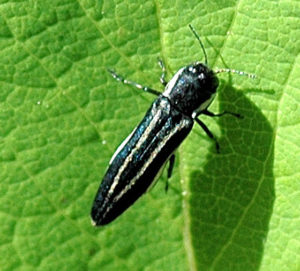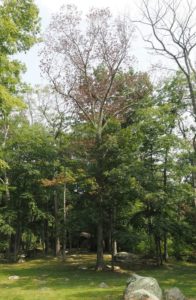 As the summer of 2018 nears its conclusion, it has become apparent that this year has been a banner year for the two lined chestnut borer in eastern Connecticut. This follows upon, and is a direct result of, the difficult past few years Quercus species have had in those parts of the state that have endured a major gypsy moth outbreak in conjunction with at least two years of significant drought, in 2015 and 2016.
As the summer of 2018 nears its conclusion, it has become apparent that this year has been a banner year for the two lined chestnut borer in eastern Connecticut. This follows upon, and is a direct result of, the difficult past few years Quercus species have had in those parts of the state that have endured a major gypsy moth outbreak in conjunction with at least two years of significant drought, in 2015 and 2016.
To recount the events of these past 3 years – this drought aided the growth in the gypsy moth population in many parts of the state east of the Connecticut River and in Middlesex and New Haven Counties by hindering the maimaiga fungus. It was apparent, by early 2017, that many of these parts of the state were facing yet another difficult year for gypsy moth defoliation. The spring rains of last year gave some hope that it would reduce the amount of defoliation and damage caused by the gypsy moth. Alas, while the fungus was triggered, it arrived on the scene too late to prevent large scale defoliation. By August of 2017, it had become obvious that the drought and the fungus together had caused serious, even severe, mortality among oaks in many parts of the state. At the time it was noted that those trees that were leafless in late August and September of that year would not leaf out again in May of 2018. That alone was a recognition of the widespread extent of oak mortality. (For a more complete summary, see the CT Agricultural Experiment Station’s 2018 Gypsy Moth Fact Sheet.)
However, many oaks that survived the combined effects of gypsy moth and drought in 2016 and 2017 leafed out im 2018 and looked fine early on. As the season progressed, however, many of these oaks began to show the effects of one of the main opportunists that will attack weakened oak trees. Agrilus bilineatus, known alternatively as the two lined chestnut borer, twolined chestnut borer, two-lined chestnut borer or TCLB, is a buprestid, or jewel beetle, in the same genus as the emerald ash borer. Its biology is very similar to the EAB’s. The adult female, after maturation feeding on a host species, lays its eggs on a suitable host tree. The larva, when it emerges, penetrates through the bark of the tree where this flathead borer consumes cambium and phloem tissue until it is ready to pupate. After a year or, in some cases, two, the adults emerge through D-shaped exit holes, where the insect then moves on to mate and restart the cycle.
The difference between the emerald ash borer and the two lined chestnut borer, however, is that the chesntut borer is a native species, originally described in the 1890’s based on its attacks on chestnut trees. Oaks and, occasionally, beech and hornbeam also fall within its host range. However, native, unstressed species of oak (and other species) are usually able to resist outbreaks of this insect and are able to survive the small number of attacks that occur. As such, in most years, two lined chestnut borer is usually not a problem with most oaks.
This year, that dynamic has changed. The vast number of gypsy moth and drought afflicted trees has led to a surge in the number of the two lined chestnut borer. Dr. Claire Rutledge of the CT Agricultural Experiment Station was one of the first to note this, from the high number of these insects that she and her wasp-watchers were collecting in the eastern parts of the state (see the Connecticut Wasp Watchers facebook page). Indeed, as the summer wore on, these borers began to show themselves through the classic symptoms of two lined chestnut borers.
These symptoms include the browning of leaves near the top of the tree as the larvae begin their feeding under the bark of branches in the upper crown. These symptoms can be initiated at any point during the summer. As the summer moves on, the symptoms will continue to show further down the tree, following the pattern of egg-laying within the crown of the tree. When the attack is in full-swing, it is not unusual to see trees with the tops of the crown full of brown, dead leaves, the middle part showing leaves turning red and yellow as they wilt and what appears to be healthy green leaves in the lower crown. Presumably, these trees are already stressed before the attack, with this infestation being the coup de grace to these trees, the final blow that kills them.
It is not known whether, simply by sheer numbers, the two lined chestnut borer can overwhelm healthy oaks. Also, this insect often does not act alone. Various pathogens, most notably the armillaria fungus, as well as other insects such as the red oak borer, may also be attacking these trees, in some cases piggybacking on the efforts of the two lined chestnut borer.
The pattern of two lined chestnut borer outbreaks are well known from past gypsy moth outbreaks, as the number of insects tend to reach a maximum following the peak year of gypsy mortality. The number of secondary deaths tends then to decline from there, due in part to the increase in parasitoids on the borers. The USDA Forest Service has produced several excellent summaries of the two lined chestnut borer, including this Forest and Insect Disease Leaflet from 1992 and this short note from Rocky Mountain Research Station in 2011.
Several pesticides list the two lined chestnut borer on their label, with recent experiences with the emerald ash borer suggesting that the treatment of prized osk trees would be worthwhile. As this is the first widespread outbreak of the two lined chestnut borer since EAB has come along, this provides a great opportunity for arborists to share notes regarding how to deal with this, not new, but suddenly widespread insect pest.

Two Lined Chestnut Borer-infested oak in eastern Connecticut

